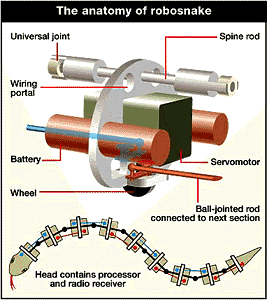| . |  |
. |
|
by Duncan Graham-Rowe  London - December 1, 1999 - Geeks growing bored with Sony's robotic dogs could one day replace their motorised mutts with another high-tech toy: a robotic snake that moves just like the real thing. The technology could also be used to create robots capable of handling the toughest terrain--perhaps even on other planets.
London - December 1, 1999 - Geeks growing bored with Sony's robotic dogs could one day replace their motorised mutts with another high-tech toy: a robotic snake that moves just like the real thing. The technology could also be used to create robots capable of handling the toughest terrain--perhaps even on other planets.Gavin Miller, an animator in Palo Alto, California, has built the most lifelike robotic snakes yet created, in his garage. He has managed to reproduce both the slithering and the sidewinding motions used by the reptiles. Previous attempts to make robotic snakes have usually involved copying the way a caterpillar inches along by arching its body upwards, rather than a snake's slither. "This is by far the most realistic and sophisticated [robotic] snake that I have seen," says Gary Haith, a robotics engineer at NASA's Ames Research Center, who is designing ways to explore rough extraterrestrial terrains. Miller originally started trying to reproduce snakes' movements for an animated film. Having developed an algorithm that worked in the virtual world, he decided to see if it would work in the real world, too. Eventually, he says, he would like to build a robot snake capable of climbing trees. Miller hopes to sell his design to toy makers. He believes he has cracked the problem that has kept toy makers away: the cost. His new design could sell for only a few hundred dollars. But it's not just about toys. Biomimetics, as copying ideas from nature is called, could push the boundaries of robotics. "The hope is if we have biologically inspired robots, they would be able to go over a wide variety of terrain," he says. Although there is a wheel under each segment of Miller's snakes, much like those on a Rollerblade, they are not motorised, says Miller. Instead they are free running and merely reduce friction with the ground. Haith says it's much harder to make snakes move naturally without wheels. Miller's latest model, a 7-kilogram polycarbonate and brass beast, has over 30 segments. The segments are connected by a central spine and each have a pair of electrical servomotors. These push the connecting rods that make the snake's segments bend (see Diagram). A motion starts at the robot's head. When the servos are activated, neighbouring segments bend in relation to each other and a sideways force is exerted on the wheels. "These lateral forces on the wheels cause it to move along," Miller explains. The motors in the next segment are then activated, and then the next, and so on. The snakes are controlled with two joysticks much like a radio-controlled aircraft. "They needed to be simple to drive," he says. One is for steering and speed. The other controls the sidewinding movement as well as lift. This article will appear in the December 4 issue of New Scientist New Scientist. Copyright 1999 - All rights reserved. The material on this page is provided by New Scientist and may not be published, broadcast, rewritten or redistributed without written authorization from New Scientist.
ROBOSPACE
|
| |||||||||
| The content herein, unless otherwise known to be public domain, are Copyright 1995-2016 - Space Media Network. All websites are published in Australia and are solely subject to Australian law and governed by Fair Use principals for news reporting and research purposes. AFP, UPI and IANS news wire stories are copyright Agence France-Presse, United Press International and Indo-Asia News Service. ESA news reports are copyright European Space Agency. All NASA sourced material is public domain. Additional copyrights may apply in whole or part to other bona fide parties. Advertising does not imply endorsement, agreement or approval of any opinions, statements or information provided by Space Media Network on any Web page published or hosted by Space Media Network. Privacy Statement All images and articles appearing on Space Media Network have been edited or digitally altered in some way. Any requests to remove copyright material will be acted upon in a timely and appropriate manner. Any attempt to extort money from Space Media Network will be ignored and reported to Australian Law Enforcement Agencies as a potential case of financial fraud involving the use of a telephonic carriage device or postal service. |